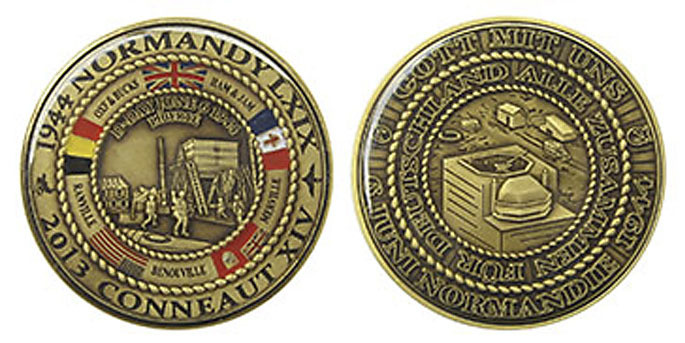2013 D-Day Conneaut Challenge Coin
2013 Challenge Coin:
Designed by Eric Montgomery
The 2013 D-Day Conneaut Challenge Coin "Hold, Until Relieved" depicts two significant events and locations synonymous with the intrepid story of that Longest Day; The British Glider Assault of the bridges at Bénouville and Ranville and the giant observation bunker in Ouistreham at the mouth of the Caen Canal and Orne River. The 2013 coin is the fifth in the commemorative coin program highlighting the significant events of the Normandy Invasion.
The Story behind the coin: About 1 hour before midnight on the Sixth of June, six Airspeed “Horsa” gliders towed by Halifax Bombers departed from an airfield in Dorset England. Their mission was to capture and hold the Caen Canal Bridge near Bénouville and the Orne River Bridge near Ranville. Just after midnight, 00:14 to be exact, the gliders landed mere yards from their objectives. The very surprised German defenders were quickly overwhelmed.
Crucial to the further success of the seaborne landings, the task of capturing these vitally strategic bridges fell to the Glider-borne Infantry of the British 6th Airlanding Brigade. Led by Major John Howard, Company D of the Oxfordshire and Buckinghamshire Light Infantry along with their attached sappers and engineers secured both bridges in little more than 10 minutes.
Sadly, the first allied causality as a result of enemy action in Normandy occurred just as the lead elements of the assault force made their way across the Bénouville Bridge. Lt. Den Brotheridge, while leading the charge across the bridge, was struck down. His body lies in the Ranville Churchyard near Caen. Ranville was the first village in France to be liberated by the allies.
The Allied side of the 2013 coin features the canal crossing assault moments after the gliders touched down. The bridge, renamed Pegasus Bridge in honor of the men who liberated it, is shown in its original construction with soldiers of the “Oxf and Bucks” racing towards it. The famous Gondrée Café can be seen across the canal and in the foreground the wing of one of the gliders. The Café serves as the annual June 6th gathering point for veterans of the battle to this day.
The operational success code words, “Ham and Jam” along the towns of Ranville, Bénouville and Merville, home to a battery of German artillery guns which threatened Sword Beach are also written on the coin. The artillery battery at Merville was initially attacked on D-Day morning by paratroopers of the 9th Parachute Battalion supported by paratroopers of the 1st Canadian Parachute Battalion. These men heroically assaulted the emplacement, destroyed the guns inside but the battery itself remained intact. The position remained under German control until August 17th when the withdrawal of German forces in France began.
Depicted on the axis side of the coin is the Flak Tower/Observation Bunker located at the mouth of the Caen Canal and Orne River in the seaside village of Ouistreham France. The Grand Bunker, from its position located only a few hundred yards from the British landing beach codenamed Sword, the German inhabitants easily surveyed the entire area. So cleverly devised, the bunker never caught the attention of D-Day invasion planners and thus was never bombed or attacked until discovered on D-Day.
The scene depicted upon the axis side shows the 52 foot high bunker from above and surrounding territory before the invasion. The concrete reinforced structure was the 6 story self contained high-rise home to 52 German soldiers. Disguised amongst homes in the area the only opening aside from the entry door was a 10 inch high slit to allow the artillery range finder within the cupola to sight in its targets. Aside from the range finder, contained inside the bunker was an electric power generator, a fresh air gas filtration system, housing for the troops, medical facilities, an armory, ammunition stores, radio room and telephone switchboard all protected by a network of overlapping machine guns. “Alle Zusammen fur Deutschland” meaning “All Together for Germany” accentuates the colossal effort to build the bunker and the Atlantic Wall, surrounds the view.
On D-Day, Franco British Commandos attacked the structure only to be beaten off by machine guns and grenades thrown from roof top gun pit. Three days later and surrounded on all sides, 4 men of the 91st Field Company of Royal Engineers, 3rd Canadian Division, breeched the armor plated reinforced door. Soon to follow was the surrender of the garrison inside and the liberation of Ouistreham was finally complete.
The Belgian Piron Brigade joined in the fight for Normandy in early August and served under the command of the British 6th Airborne Division. The unit initially was held in reserve to liberate their homeland but Major Jean-Baptiste Piron, commander of the 1st Belgian Infantry Brigade lobbied his exiled government to petition the British command join in the fight. The Belgian flag joins the flags of Britain, Canada, France and the United States for its first appearance on a D-Day Conneaut coin.
Remaining features of the commemorative coin celebrate the 69th anniversary of D-Day, (LXIX), and our 14th year (XIV) of the event here in Conneaut. The uniform shoulder insignia of the British Airborne forces, the flying horse Pegasus and their famous red beret cap insignia serves to separate the dates of the coin. Lastly the signature “Liberté” which has been on every D-Day Conneaut coin caps the allied side.
